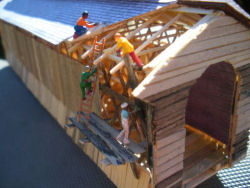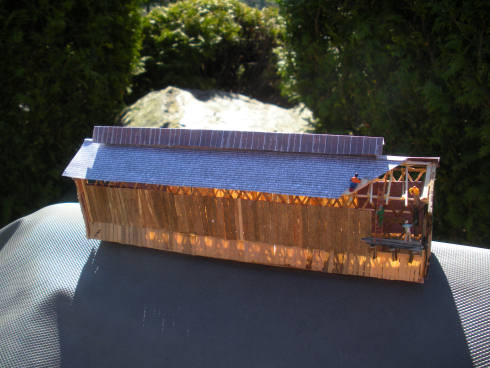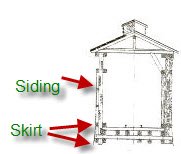|
Bridge Completion Adds N Scale Gem
But this is a project I have been looking forward to finishing the siding, roofing and actually running a N Scale train through the structure on my “in progress” layout. But getting to that point took some time. To begin with, my Chopper II really got a workout clipping over 350 N Scale 15-foot 2X8s (.012” X .048”) from 11” Stripwood pieces. Before beginning the cutting, you can save yourself a real hassle by getting the lumber to the finished color you want. I used differing shades of diluted waterbase FolkArt Acrylic paint. The base was Mushroom color with dabbles of Chocolate color or dove grey. In reality, leaving a covered bridge in a half-finished state for three months during springtime flooding would be inexcusable. Just a day without riggers on the job would expose the bridge to unneeded risk. In the N Scale world hospitalization makes the late finish at least tolerable. But this is a project I have been looking forward to finishing the siding, roofing and actually running a N Scale train through the structure on my “in progress” layout. But getting to that point took some time. When I got the color to the shade desired, I mixed it six teaspoons water to one of the paint. I used each mixed color to swab down both sides of three pieces of stripwood. Let them dry under pressure to minimize warping. I find some gaps between boards to be realistic. I also dabbled black acrylic in a random pattern on a few strips to simulate tar, oil or creosote. Now, for a little cutting up; if you haven’t invested in a Northeastern Chopper, this is the project where it will prove invaluable. You may want to take this in stints because even if you could continuously load, feed and cut the 35 strips for the three hours it will take to produce 350 N Scale 15-footers, you need to glue them to the chords in groups of 25-30 at a time. When I got the color to the shade desired, I mixed it six teaspoons water to one of the paint. I used each mixed color to swab down both sides of three pieces of stripwood. Let them dry under pressure to minimize warping. I find some gaps between boards to be realistic. I also dabbled black acrylic in a random pattern on a few strips to simulate tar, oil or creosote. Now, for a little cutting up; if you haven’t invested in a Northeastern Chopper, this is the project where it will prove invaluable. You may want to take this in stints because even if you could continuously load, feed and cut the 35 strips for the three hours it will take to produce 350 N Scale 15-footers, you need to glue them to the chords in groups of 25-30 at a time.
Hardly any of these covered bridges exit very long without sustaining damage that tends to show first in the siding and skirting in the Northeast. Ice did much damage to the bottom of these bridges in spring time as it coursed down the river. 
Siding boards were often split either from internal accidents or exterior mishaps. You can duplicate this by using a pair if pliers to chew at the bottom of the bridge to simulate ice damage. Remember it is ONLY the upriver side that sustains this kind of damage. Breaking individual siding boards also gives your bridge that “lived in look”, but don’t get carried away. No more than five or ten boards per side. Let’s Go Topside The main viewing of your bridge will most likely begin from the roof down. This is where you want to put you most effort with added detail. Despite the fact it is unlikely work crews would ever be on the roof or side of a covered bridge as a train passes on the tracks below, I wanted to depict the major undertakings to maintain and save these structures in real life. I set up a five-man crew working on the roof and siding of the bridge from staging and a ladder provides the detail I wanted to use to illustrate this reality. The shingles for this structure are from roofing printed from my computer using Model Builder Software which offers a variety of roofing materials for a project like this. The N Scale workman is applying rubber cement to hold the roofing in place.
Actually, I call on Model Builder printouts for a variety of projects like this, primarily roofing, but the cupola grill requires a full length grill on both sides for smoke release. Making these grills from scratch would be difficult at best. Since they are largely concealed by the cupola roof, being able to print out a full length, too scale grill section is a major time saver. I have several buildings on this layout which are paper models in 3-D and I believe they add much. For other N Scale roofing sources you have paper shingles at about $6.00 to $12 a sheet and there is also N Scale corrugated roofing. All in all this is a project I was sort of disappointed to see come to an end. The research alone activated a lot of memories of my life as a youngster in Vermont and in fact, served as the trigger to model a section of the St. J. and L.C. Railway in Northeastern Vermont which includes the Fisher Covered Bridge.
|





